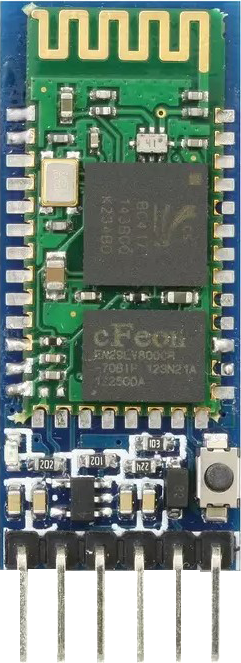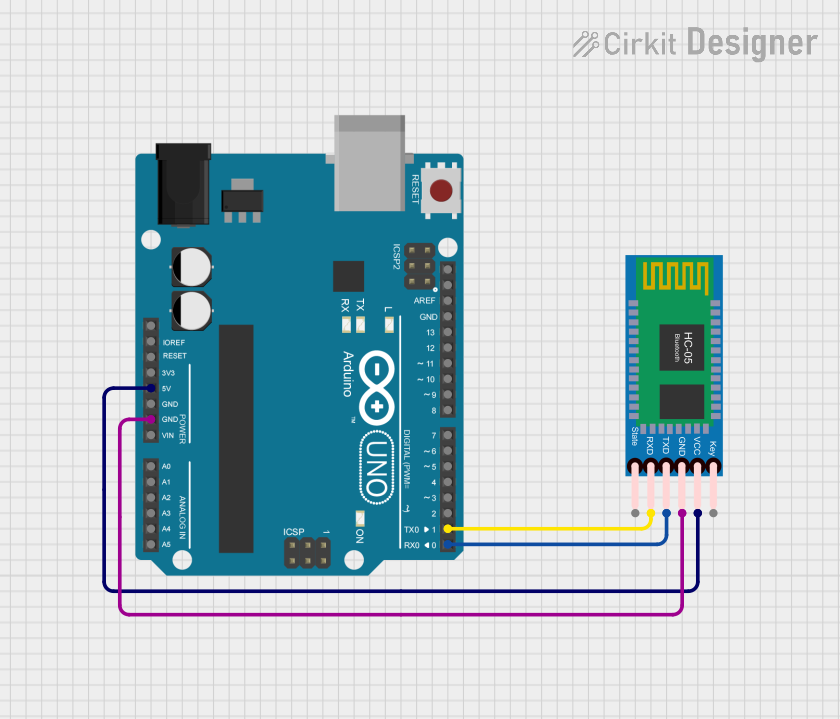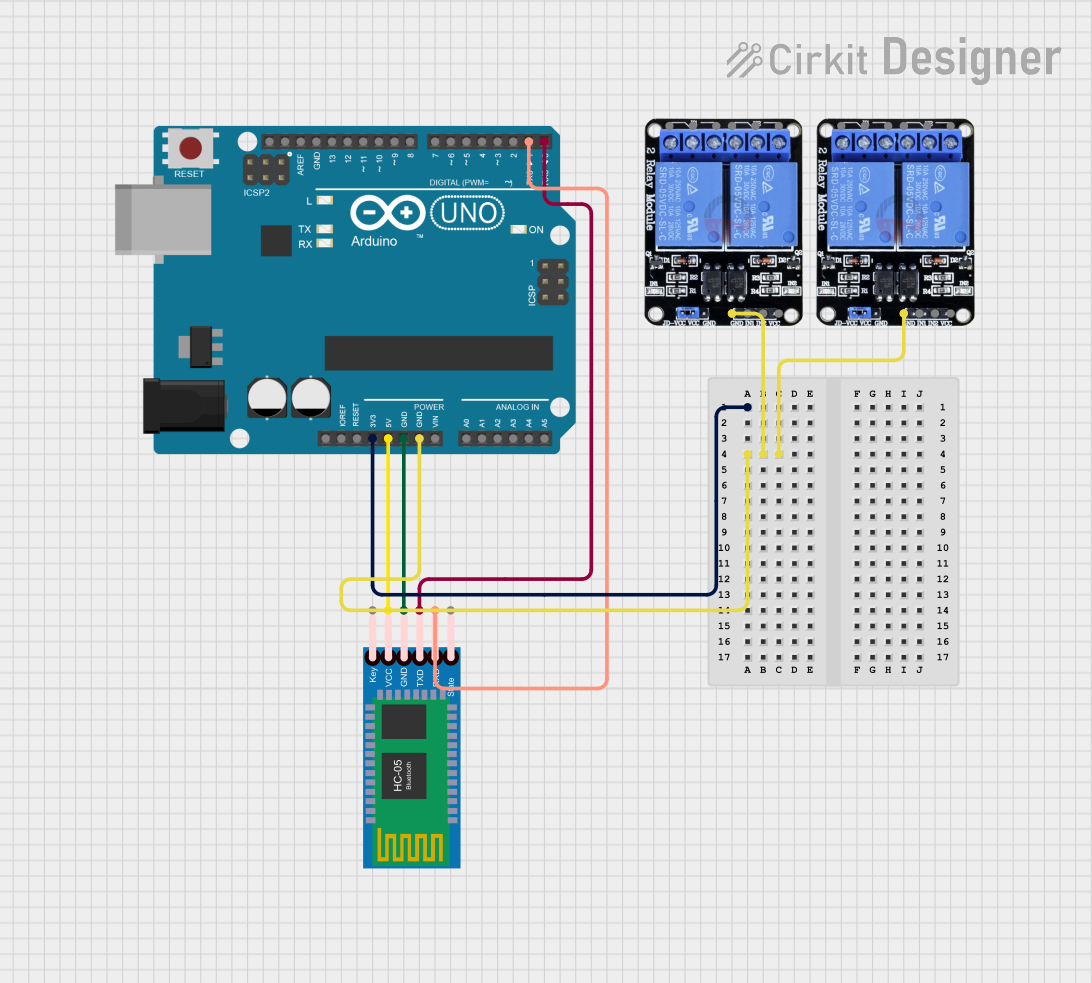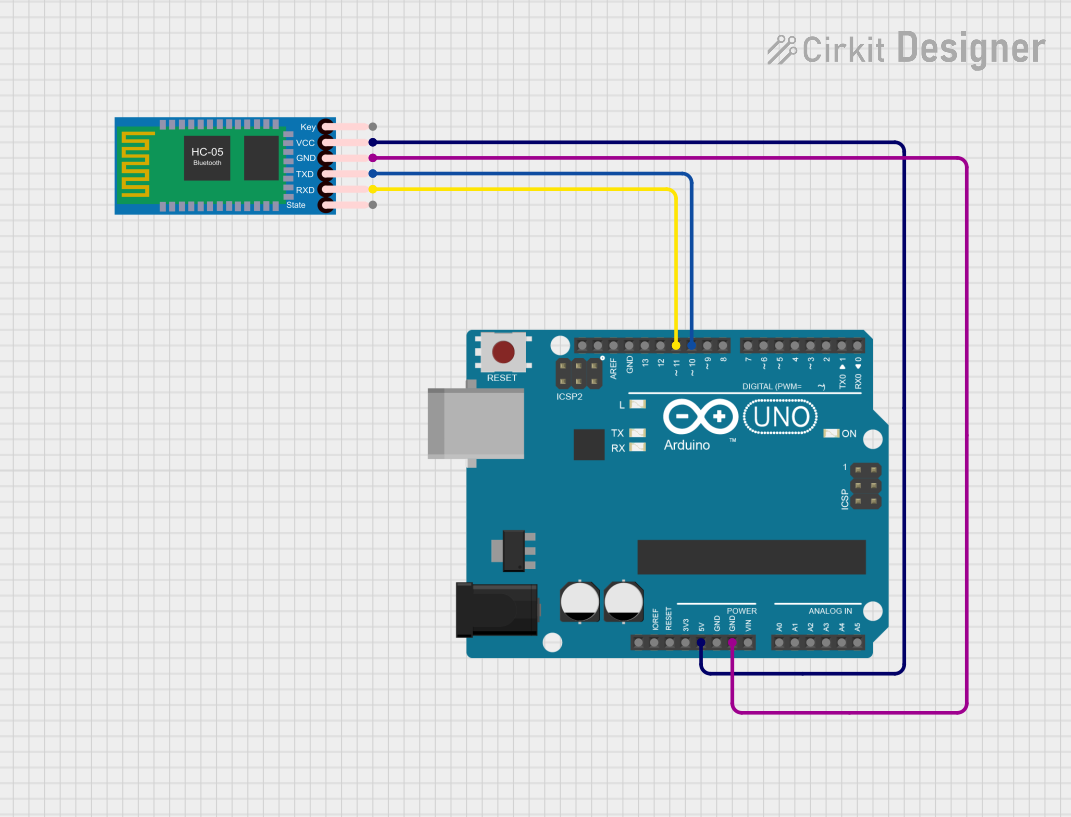
How to Use HC-05 Bluetooth Module: Examples, Pinouts, and Specs

 Design with HC-05 Bluetooth Module in Cirkit Designer
Design with HC-05 Bluetooth Module in Cirkit DesignerIntroduction
The HC-05 Bluetooth Module is a wireless communication module designed for short-range data transmission using Bluetooth technology. It is widely used in embedded systems, IoT projects, and other applications requiring wireless communication between devices. The module supports both master and slave modes, making it versatile for various use cases.
Explore Projects Built with HC-05 Bluetooth Module

 Open Project in Cirkit Designer
Open Project in Cirkit Designer
 Open Project in Cirkit Designer
Open Project in Cirkit Designer
 Open Project in Cirkit Designer
Open Project in Cirkit Designer
 Open Project in Cirkit Designer
Open Project in Cirkit DesignerExplore Projects Built with HC-05 Bluetooth Module

 Open Project in Cirkit Designer
Open Project in Cirkit Designer
 Open Project in Cirkit Designer
Open Project in Cirkit Designer
 Open Project in Cirkit Designer
Open Project in Cirkit Designer
 Open Project in Cirkit Designer
Open Project in Cirkit DesignerCommon Applications and Use Cases
- Wireless communication between microcontrollers and smartphones
- Remote control of devices (e.g., robots, home automation systems)
- Data logging and monitoring applications
- Wireless programming of microcontrollers
- IoT projects requiring Bluetooth connectivity
Technical Specifications
The HC-05 module is a compact and reliable solution for Bluetooth communication. Below are its key technical details:
Key Technical Details
- Bluetooth Version: 2.0 + EDR (Enhanced Data Rate)
- Operating Voltage: 3.3V to 5V
- Operating Current: 30mA (typical)
- Communication Range: Up to 10 meters (unobstructed)
- Baud Rate: Configurable (default: 9600 bps)
- Modes: Master and Slave
- Communication Protocol: UART (Universal Asynchronous Receiver-Transmitter)
- Default PIN Code: 1234
- Dimensions: 37.5mm x 15.2mm x 3.5mm
Pin Configuration and Descriptions
The HC-05 module has 6 pins, as described in the table below:
| Pin Name | Description |
|---|---|
| VCC | Power supply pin (3.3V to 5V). |
| GND | Ground pin. Connect to the ground of the circuit. |
| TXD | Transmit pin. Sends serial data to the connected device. |
| RXD | Receive pin. Receives serial data from the connected device. |
| EN (Key) | Enable pin. Used to switch between command mode and data mode. |
| STATE | Status pin. Indicates the connection status (HIGH when connected, LOW otherwise). |
Usage Instructions
The HC-05 module is straightforward to use in a circuit. Below are the steps and best practices for integrating it into your project.
How to Use the HC-05 in a Circuit
- Power the Module: Connect the VCC pin to a 3.3V or 5V power source and the GND pin to the ground.
- Connect TXD and RXD:
- Connect the TXD pin of the HC-05 to the RX pin of your microcontroller.
- Connect the RXD pin of the HC-05 to the TX pin of your microcontroller. Use a voltage divider if your microcontroller operates at 5V logic levels to avoid damaging the module.
- Enable the Module: Leave the EN pin unconnected for normal operation. Pull it HIGH to enter command mode.
- Pair the Module: Search for the HC-05 on your Bluetooth-enabled device, pair using the default PIN code (1234), and establish a connection.
- Send and Receive Data: Use UART communication to send and receive data between the HC-05 and the connected device.
Important Considerations and Best Practices
- Voltage Levels: The RXD pin is not 5V tolerant. Use a voltage divider or level shifter if your microcontroller operates at 5V logic levels.
- Command Mode: To configure the module (e.g., change the baud rate or name), pull the EN pin HIGH and send AT commands via UART.
- Antenna Placement: Ensure the module's antenna is not obstructed by metal objects to maintain optimal communication range.
- Baud Rate Matching: Ensure the baud rate of the HC-05 matches the baud rate of the microcontroller for proper communication.
Example: Connecting HC-05 to Arduino UNO
Below is an example of how to use the HC-05 module with an Arduino UNO to send and receive data.
Circuit Connections
- HC-05 VCC → Arduino 5V
- HC-05 GND → Arduino GND
- HC-05 TXD → Arduino RX (Pin 0)
- HC-05 RXD → Arduino TX (Pin 1) (use a voltage divider if needed)
Arduino Code
// Example code to send and receive data using HC-05 Bluetooth Module
#include <SoftwareSerial.h>
// Define RX and TX pins for SoftwareSerial
SoftwareSerial BTSerial(10, 11); // RX = Pin 10, TX = Pin 11
void setup() {
// Initialize serial communication
Serial.begin(9600); // For communication with the PC
BTSerial.begin(9600); // For communication with HC-05
Serial.println("HC-05 Bluetooth Module Test");
Serial.println("Send data via Bluetooth to see it here.");
}
void loop() {
// Check if data is available from HC-05
if (BTSerial.available()) {
char data = BTSerial.read(); // Read data from HC-05
Serial.print("Received: ");
Serial.println(data); // Print received data to Serial Monitor
}
// Check if data is available from Serial Monitor
if (Serial.available()) {
char data = Serial.read(); // Read data from Serial Monitor
BTSerial.write(data); // Send data to HC-05
Serial.print("Sent: ");
Serial.println(data); // Print sent data to Serial Monitor
}
}
Troubleshooting and FAQs
Common Issues and Solutions
Module Not Powering On:
- Ensure the VCC pin is connected to a 3.3V or 5V power source.
- Check for loose connections or damaged wires.
Unable to Pair with Device:
- Verify that the module is powered on and in range.
- Ensure the default PIN code (1234) is entered correctly.
- Check if the module is already paired with another device.
No Data Transmission:
- Confirm that the TXD and RXD pins are correctly connected.
- Ensure the baud rate of the HC-05 matches the microcontroller's baud rate.
- Use a voltage divider on the RXD pin if the microcontroller operates at 5V logic levels.
AT Commands Not Working:
- Ensure the EN pin is pulled HIGH to enter command mode.
- Use a baud rate of 38400 bps for AT commands (default for HC-05 in command mode).
FAQs
Q: Can the HC-05 module work with 5V logic levels?
A: The TXD pin can output 5V logic, but the RXD pin is not 5V tolerant. Use a voltage divider or level shifter for safe operation.Q: How do I change the module's name or PIN code?
A: Enter command mode by pulling the EN pin HIGH and send the appropriate AT commands (e.g.,AT+NAME=NewName,AT+PIN=5678).Q: What is the difference between master and slave modes?
A: In master mode, the HC-05 can initiate connections with other Bluetooth devices. In slave mode, it waits for incoming connections.
By following this documentation, you can effectively integrate the HC-05 Bluetooth Module into your projects and troubleshoot common issues.